Text
Ultimate fate of the universe
Galaxies are spreading while returning some of their momentum energy back into the vacuum space. The momentum energy was given from the vacuum space at the time of the birth of the universe. The returned energy expands the vacuum space.
When all the momentum energy is returned, no energy is given to the vacuum space. In that case, if the vacuum space tries to expand, the vacuum energy density will decrease, but it is the lower limit and cannot be reduced any further. Therefore, the expansion of the vacuum space stops.
The expansion of the universe will stop in the distant future.
After this, the size of the universe follows the following Einstein field equations.

Real matters such as galaxies gather by gravity while borrowing energy from the vacuum space as momentum energy. At the same time, the vacuum space contracts as it gives energy to real matters.
The universe contracts slowly at first, its contraction rate gradually increases, and finally it contracts rapidly. Then, the energy densities of all real matters reach the upper limit value, which causes their total energies to be converted into light quanta. At the same time, all imaginary matters disappear.
The disappearance of all real matters means that the time velocity disappears. The space velocity also disappears because the space is too small for light quanta to move. Since both the time velocity and space velocity disappear, all energy in the real space is converted into the vacuum energy with neither space velocity nor time velocity.
Since the sum of the mass energies of real matters and imaginary matters is zero, the momentum energy of real matters is actually converted into the vacuum energy.
Then, cosmic inflation occurs again. The vacuum energy causes a phase transition when its volumetric density decreases to a certain level, and electrons and positrons are generated in pairs in the real space and imaginary electrons and imaginary positrons are generated in pairs in the imaginary space.
The Creator designs new blueprints for next-generation objects and creatures and grants neutrinos, the makers of all things, to some of electrons and positrons.
We live in a universe created by such a cosmic cycle.
To the Creator, the lifespan of a universe is like the lifespan of a man in human history.
#science#physics#universe#creation of the universe#kinetic energy#vacuum energy#dark energy#11 dimensions#Einstein field equations#expansion of the universe#Big Crunch#cosmic inflation#cosmic creation cycle
4 notes
·
View notes
Text
Energy density has limit value
The Schwarzschild radius is one of the solutions of the Einstein field equations and is expressed as follows:

where G is the gravitational constant, M is the object mass, and c is the speed of light.
When the object of mass M is compressed into the space corresponding to the sphere of radius rs, a singularity is generated.
However, in order to prevent objects from entering the vacuum space (four spatial dimensions), where is the singularity region, a mechanism was created in which the vacuum resistance becomes infinitely large as the speed of objects approaches the speed of light. Likewise, there should be a mechanism to prevent objects from entering the vacuum space when their energy densities reach the upper limit value.
If mass M becomes zero, Schwarzschild radius rs becomes zero, then the singularity disappears. Therefore, when the energy density of matter reaches the limit value, its energy is converted into light quanta with zero mass.
There is no coin-sized black hole, so we don't have to worry about its threat.
To prevent objects from entering the vacuum space, the universe prohibits them from moving at the speed of light and their energy densities from exceeding the limit value.
#science#physics#universe#creation of the universe#general relativity#Einstein field equations#Schwarzschild radius#gravitational singularity#energy density#11 dimensions
2 notes
·
View notes
Text
Finally life-full planets were born
Hydrogen atoms were bonded to form hydrogen molecules. Helium can exist as a single atom gas.
More molecules were produced where the neutrino-given electrons and positrons were denser, and the attractive gravity at those locations was stronger than at other locations. As a result, nearby molecules were attracted. Gravity became stronger as molecules gathered, attracting more molecules. When a mass of real molecules was formed, imaginary molecules corresponding to real molecules surrounded the mass through the vacuum space and pressed it by repulsive gravity. This increased the energy density of the mass and made its attractive gravity stronger.

By repeating this cycle for a long period of time, molecular clouds were formed. Eventually molecular clouds contracted due to their own gravity, and the molecular cloud began nuclear fusion when its mass increased to roughly 8% of the mass of the sun. At last, the first star was born. It was an event hundreds of millions of years after the birth of the universe.
Galaxies and galaxy clusters were formed as the number of stars increased. Imaginary matters also played the role of pressing galaxies in the process of their forming.
Atoms heavier than hydrogen and helium were produced by means of nuclear fusion and supernova, and planets composed of these heavier atoms were formed around stars. Finally life-full planets like the earth, which are the purpose of the creation of the universe, were born.
The Creator created the universe in this way.
The earth we live in is one of the planets of the solar system and is in the habitable zone. The solar system is located in the Milky Way's galactic habitable zone. The Milky Way Galaxy has more than 200 billion stars, and there are more than 200 billion galaxies in the observable range of the universe. Nevertheless, the vacuum occupies most of the real space.
#science#physics#universe#creation of the universe#gravity#molecular cloud#star#planet#galaxy#dark matter#11 dimensions
0 notes
Text
Neutrinos were given only to some of electrons and positrons
Electron-positron pairs were uniformly generated in the real space at the end of cosmic inflation. However, if the spatial distribution of objects is perfectly uniform, no stars will be born. Therefore, the Creator granted neutrinos only to some of electrons and positrons, creating nonuniform in their spatial distribution.
The neutrino-given electrons and positrons were bound by the neutrinos according to the design of the Creator to create neutrons. Next, protons, nuclei, and atoms were made.
All electrons and positrons that were not given neutrinos were annihilated and converted into electromagnetic waves. This radiation is currently observed as the cosmic microwave background coming from all parts of the sky. The image below (from Wikipedia) shows the cosmic background radiation observed by WMAP.

The radiation is isotropic to about 1 / 100,000. This small anisotropy became cores for making stars.
#science#physics#universe#creation of the universe#neutrino#electron#positron#annihilation#cosmic microwave background
1 note
·
View note
Text
Atoms were made
The universe continued to expand as part of the momentum energy of objects, which had been given after cosmic inflation, was returned to the vacuum space. When the momentum energies of nuclei and electrons decreased sufficiently after hundreds of thousands of years, nuclei incorporated electrons to form atoms. At last atoms were born.
Hydrogen atoms and helium atoms now occupy 99% or more of the atoms in the universe in terms of number ratio. Most of them were made at the beginning of the creation of the universe.
Helium, which has about four times the energy density of hydrogen, was essential for the formation of the first star.

The repulsive quantum degeneracy pressure of each orbital electron is controlled against the attractive Coulomb force between the negatively charged electron and the positively charged nucleus so that the electron orbital structure is maintained. Neutrinos control electron degeneracy pressure.

Since the attractive electromagnetic force between atoms is larger than the sum of the repulsive electromagnetic forces between electrons and between nuclei, it is impossible to bond atoms to form a molecule if there is no electron degeneracy pressure.
The closer the orbital electron is to the nucleus, the stronger the Coulomb force applied to it, so its energy should be larger. An excited orbital electron returns to the original state after emitting light. At that time, the sum of the emitted light quantum's energy and the increased amount of the electron's energy is borrowed from the vacuum space. As a result, the orbital electron have more energy in the original state than in the exited state. It is natural that the transition of an inner orbital electron emits more energy.
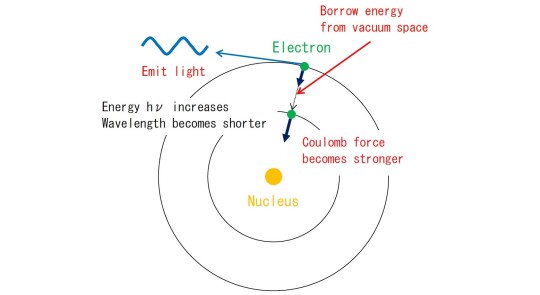
The order in which electrons fill the shells and subshells follows the design of the Creator. This order made transition elements that acted as catalysts for various chemical reactions in the early stages of biological evolution.

#science#physics#universe#creation of the universe#atom#nucleus#orbital electron#electron degeneracy pressure#atomic electron transition#electron shell#vacuum energy#dark energy#11 dimensions
0 notes
Text
Split of nucleons
In order to split the proton-neutron binding system into a proton and a neutron again, it is necessary to give the system at least the same energy as the emitted gamma ray energy. Then, the sum of the gamma ray energy (γ) and the energy added to the neutron (purple frame part) is returned to the vacuum space, and the nuclear force disappears. As a result, the proton-neutron binding system splits into a proton (p) and a neutron (n).

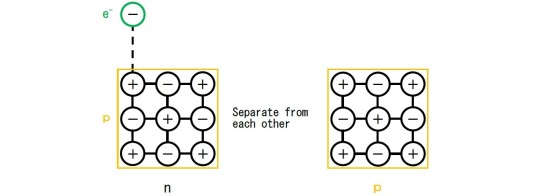
The sum of the emitted gamma ray energy and the energy added to the neutron is the total energy debt from the vacuum space. This is the potential energy associated with the nuclear force. The proton and neutron are released from the binding state by returning all the potential energy to the vacuum space.
When the proton-neutron binding system is given more energy than the potential energy, the system splits into a proton and a proton-muon combination, and the proton-muon combination decays into a free proton and a negative muon (μ-).
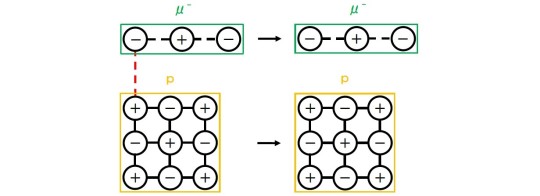
#science#physics#universe#creation of the universe#neutron#proton#muon#nuclear force#potential energy#vacuum energy#dark energy#11 dimensions
0 notes
Text
Alternating muon catches between protons
I explain the alternating catches of a negative muon between two protons.
The binding energy between the proton (p) and the negative muon (μ-) is converted into the momentum energy of the negative muon, and the negative muon is separated from the proton.


When another proton receives the negative muon, the momentum energy of the negative muon is converted into the binding energy between the proton and the negative muon, and the proton combines the negative muon.

The protons alternately receive the negative muon by repeating this process.
It is easy to understand if you imagine that there is a negative muon in the middle of two protons as shown in the figure below.

The protons are pulled by the negative muon. When the protons approach each other, the repulsive force between the protons increases rapidly, so the protons combine at a balanced interval between the attractive nuclear force and the repulsive electromagnetic force.
Neutrinos control nucleon binding.
#science#physics#universe#creation of the universe#proton#muon#neutrino#nuclear force#electromagnetic force
0 notes
Text
Nuclei were made
Protons themselves became the nuclei of hydrogen atoms (protiums). Neutrons that had not decayed combined with protons to form the nuclei of deuterium.
On the scale of the size of nuclei, a neutron (n) exhibits the properties as a combination of a proton (p) with three-dimensional size and an electron (e-) without size because the distance between the proton and the isolated single electron is relatively long. Therefore, the interacting a proton and a neutron have a stronger electromagnetic repulsive force than an attractive force between the proton and the electron of the neutron.
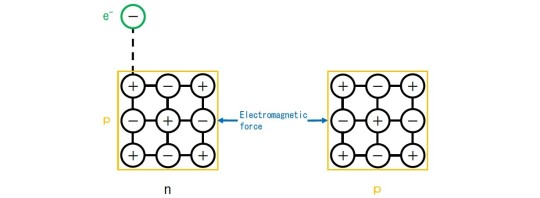
The momentum energy given to objects at the end of cosmic inflation was large enough for protons and neutrons to approach each other against the repulsive forces between them, and they were combined by the following procedure.
In order for a proton and a neutron to combine, the proton-neutron system must borrow energy from the vacuum space according to the principle of potential energy because their combining means a transition to a binding state with a higher energy density. Therefore, when a proton and a neutron come close enough to generate the nuclear force, a neutral meson (π0) is generated from the vacuum space. A part of the π0 is emitted as a gamma ray (γ), and the rest of the π0 is given to the electron of the neutron, which is transformed into a negative muon (μ-). At the same time, the nuclear force is generated.

When a proton and a neutron approach each other, their speeds are rapidly reduced by the repulsive electromagnetic force between them, and their momentum energies are returned to the vacuum space. Therefore, it can be considered that the returned energy is again given to the proton-neutron system from the vacuum space and emitted as a gamma ray.
The nuclear force is maintained by alternately catching a negative muon between protons.
Protons alone cannot constitute stable nuclei other than protiums. Neutrons are essential for the formation of atomic nuclei. The reason is that negative muons cannot be produced without neutrons in a nucleus. Protons cannot combine stably without negative muons.
Uranium nuclei undergo fission by colliding with neutrons in a nuclear reactor. Thus, the nuclear force is much weaker than the strong force.
Since the mean lifetime of free neutrons, about 15 minutes, was so reasonable, protons that had been made by the decay of neutrons combined with neutrons that had not decayed yet to form deuterium nuclei. Furthermore, helium nuclei were made based on deuterium nuclei.
Neutrons were instantaneously created when electrons and positrons were generated at the end of cosmic inflation. After that, atomic nuclei of hydrogen and helium were made within 15 minutes or more.
#science#physics#universe#creation of the universe#neutron#proton#muon#gamma ray#nuclear force#potential energy#energy density#vacuum energy#dark energy#11 dimensions
0 notes
Text
Muon decay
I ignore neutrinos here for conciseness.
The dominant decay mode of a negative muon (μ-) is into an electron (e-).

Sometimes, an electron-positron pair is additionally produced in the dominant decay mode.

The negative muon can decay into an electron and a light quantum (γ)as the extremely rare neutrino-less decay mode.

The decay process of a negative muon (μ-) becomes that of a positive muon (μ+) by exchanging electrons (e-) and positrons (e+) with each other.
Free baryons eventually decay into protons, mesons, and light quanta. Mesons decay into muons, electrons, positrons, and light quanta. Furthermore, muons decay into electrons, positrons, and light quanta.
It is understandable that protons remain until the end of the decay process of free baryons because they have a strong structure in which electrons and positrons are bound by the strong forces.
Electrons and positrons also remain until the end of the decay process of free baryons. This suggests that electrons and positrons are ultimate parts of all objects.
1 note
·
View note
Text
Pion decay
I ignore neutrinos here for conciseness.
The dominant decay mode of a neutral pion (π0) is into two light quanta (γ).

The second largest π0 decay mode is the Dalitz decay.
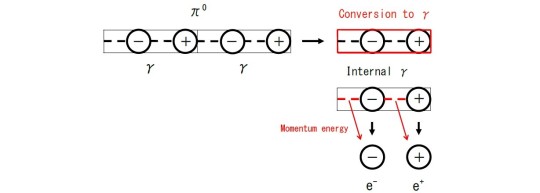
The third largest π0 decay mode is the double-Dalitz decay.
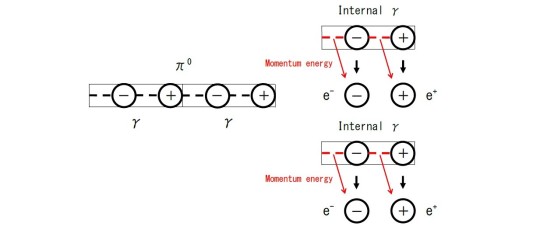
The fourth largest π0 decay mode is into an electron (e-)-positron (e+) pair.

The neutral pion has also been observed to decay into positronium.

The primary decay of a negative pion (π-) is a leptonic decay into a muon (μ-).

The second common π- decay mode is a leptonic decay into an electron.

Beyond the purely leptonic decays of pion, some radiative leptonic decays (that is, decay into the usual leptons and a light quantum) have also been observed.

The very rare "pion beta decay" is into a neutral pion and an electron.

The decay process of a negative pion (π-) becomes that of a positive pion (π+) by exchanging electrons and positrons with each other.
1 note
·
View note
Text
Assembly drawings of artificial baryons
I show how artificial baryons, which are made by colliding charged particles with each other at a speed close to the speed of light, are assembled with electrons and positrons as parts.
The figures below show the assembly drawings of low mass artificial baryons. In the figures, the solid lines represent the strong forces and the dotted lines represent the weak forces. However, all bonds that decay naturally are represented as the weak forces.



As can be seen from the assembly drawings, the masses of these artificial baryons are larger than that of neutron.
Artificial baryons decay instantly (mean lifetime: less than 1 nanosecond) to lighter baryons, mesons and light quanta. The reason for the instant decay is that artificial baryons do not conform to the design of the Creator.
A light quantum γ is added to the baryon and meson which Σ- and Ξ- commonly decay to. However, this is rational in terms of mass energy.
I think that there are two types of assembly drawings for π0 and π- (π+) as shown in the figures below.


0 notes
Text
Growing suspicion of the quark model
I ignore neutrinos here for conciseness.
The table below shows the mass energies and mean lifetimes of proton and neutron.

The quark model:
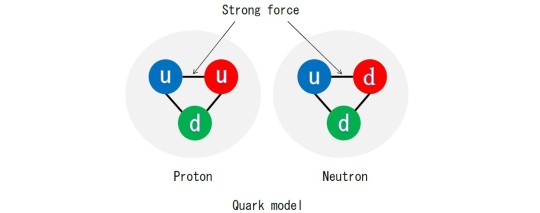
(1) Although both proton and neutron consist of three quarks bound by the strong forces, the mean lifetime of free neutrons is less than 15 minutes, while the lifetime of stable protons may be infinite. This is difficult to understand.
(2) Although quarks are elementary particles, a down quark of a free neutron decays to an up quark and an electron. Isn't this a contradiction?

The proposed model:

(1) The lifetime of protons may be infinite because all elementary particles that make up them are bound by the strong forces as shown in the proton assembly drawing. On the other hand, neutrons have a mean lifetime of less than 15 minutes because the isolated electron bound by the weak force shown in the neutron assembly drawing is easily separated. These are rational.
(2) The following is clear from the neutron assembly drawing. A free neutron denoted by "n" decays to a proton denoted by "p" and an electron denoted by "e-".

The mass energy of neutron is larger than the mass energy of proton by the sum of the mass energy of electron and the potential energy associated with the weak force (the measurement results prove this).
The basics of the universe should be simple. That is why rational principles and laws dominate the universe and we are alive.
#science#physics#universe#creation of the universe#proton#neutron#quark#electron#positron#strong force#weak force#beta decay
0 notes
Text
First neutrons were assembled
Electrons and positrons in the real space and imaginary electrons and imaginary positrons in the imaginary space were generated at the end of cosmic inflation. At the same time, the Creator granted neutrinos to electrons and positrons.
First neutrinos-given electrons and positrons were bound by neutrinos with the strong forces to create neutrons. The assembly drawing of neutron is shown in the figure below. Naturally, the number of electrons is equal to the number of positrons.
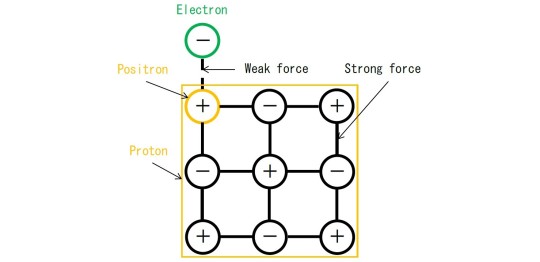
However, protons are indispensable for atoms. For this reason, the binding force of the isolated single electron was extremely weakened. Hence this electron was given the property of easy separation (mean life time: about 15 minutes). This was done by neutrinos. This weakened force is the weak force.
Since the lifetime of proton is assumed to be infinite from the experimental results, proton is considered to have the strong structure in which electrons and positrons are bound by the strong forces (see the above figure).
When free neutrons decayed after their lifetime, they separated into protons and electrons. Protons were made in this way. This is consistent with the fact that the number of orbital electrons is basically equal to the number of protons in atoms.
Since electrons and positrons were generated in pairs, it is natural to think that their numbers are exactly equal. However, although electrons exist inexhaustibly, positrons are hardly present alone. The reason is that the positron paired with an electron is in a proton.
The number of positrons is one more than the number of electrons in a proton. The electric charge of this extra positron appears as the charge of proton. The charge of electron and the charge of proton are equal with an accuracy of 21 decimal places after the decimal point. This accuracy is natural if the charge of proton is essentially the charge of positron, which is the antiparticle of electron.
As described above, when electrons and positrons were generated and given neutrinos, neutrons were instantaneously assembled with neutrinos-given electrons and positrons. After that, neutrons decayed, making protons and electrons.
#science#physics#universe#creation of the universe#neutron#proton#electron#positron#neutrinos#strong force#weak force
2 notes
·
View notes
Text
Binding of elementary particles
"An electron and positron are bound by forces" means that the attractive and repulsive forces acting between an electron and positron are balanced.

The binding of an electron and positron means a transition to a binding state with a higher energy density. To do this, the electron-positron system must borrow energy from the vacuum space due to the principle of potential energy. Therefore, a glue particle is generated from the vacuum space. The energy of a glue particle corresponds to the energy debt from the vacuum space, which is the potential energy (binding energy) associated with the forces acting on the electron and positron.
The conceptual diagrams below show the concept that attractive and repulsive forces are generated by a glue particle. The electric charge of the glue particle is neutral, but it is polarized into positive charge and negative charge, and the charge is an integer multiple of the elementary charge because the glue particle is a boson.



The glue particle spins to generate alternating attractive and repulsive forces. These forces are balanced so that the electron and positron remain stationary. The neutrinos control this process. These forces are called the strong force.
The energy of a glue particle accounts for most of the mass energy of the electron-positron binding system except for the weak binding. The distance between the electron and positron is the length of the binding system.

The difference between the number of electrons and the number of positrons determines the electric charge of their combination. If the number of electrons is the same as the number of positrons, the charge is "0". If the number of electrons is one more than the number of positrons, the charge is "-". If the number of positrons is one more than the number of electrons, the charge is "+".
#science#physics#universe#creation of the universe#electron#positron#gluon#strong interaction#strong force#potential energy#binding energy#vacuum energy#dark energy#11 dimensions
0 notes
Text
Neutrinos are makers of all things
Electrons and positrons are ultimate parts, and the balance between attractive and repulsive forces is a glue. However, objects cannot be made with parts and glues alone. Assembly drawings and makers are more required.
If the types of atoms are the same, they have the same structure and the same properties. Atoms were not made by chance. Therefore, there should be assembly drawings for assembling parts to make atoms.
Neutrinos are makers which assemble parts with glues according to the assembly drawings. Neutrino has no electric charge, and its mass is negligibly small compared to that of electron which is an elementary particle. However, neutrinos play the most important role for the creation of the universe. Antineutrinos pair with electrons and neutrinos with positrons which are antiparticles of electrons.
Electrons and positrons have their mirror images which are imaginary electrons and imaginary positrons respectively in the imaginary space, but neutrinos do not have their mirror images. The reason is as follows. Only real matters are constituents as the leading role of the universe. Imaginary matters are subordinates to real matters. Therefore, neutrinos were granted only to electrons and positrons by the Creator of the universe.
Neutrinos are the true "God Particles".
And it was the Creator that designed the assembly drawings.
0 notes
Text
Why is gravity much weaker than electromagnetic force?
Assuming that there is no energy in the real space, the vacuum energy in the four-dimensional vacuum space is distributed uniformly. If a real matter exists in the real space, distortion occurs in the vacuum energy distribution (VED). The magnitude of the distortion depends on the magnitude of the energy density of a real matter. The region where VED is distorted is the gravitational field. The distortion of VED exerts an attractive force between real matters. This is gravity. On the other hand, repulsive gravity interacts between a real matter and imaginary matter through the vacuum space because the energy of matter causes distortion in VED in the 4D vacuum space.
The distortion of VED and the curvature of spacetime are the same.
Distortion occurs in VED also due to the acceleration of an object, and vacuum resistance is generated by this distortion in the direction opposite to the acceleration.
Furthermore, distortion occurs in VED even if an object changes the direction of motion. This distortion generates centrifugal force.
Electric charge causes distortion in VED in the 3D boundary with the 4D vacuum space, and the magnitude of the distortion depends on the magnitude of electric charge. This distortion exerts a force between electrically charged particles. This is Coulomb force.
The motion of an electrically charged particle also causes distortion in VED in the 3D boundary. This distortion generates magnetic force.
The difference in the magnitude of gravity and the electromagnetic force is the difference in the magnitude of the distortion caused by the energy of matter and electric charge. In short, electric charge causes overwhelmingly large distortion compared to the energy of matter. The reason is that the energy of matter causes distortion in VED in the 4D vacuum space, whereas electric charge causes distortion only in VED in the 3D boundary with the 4D vacuum space.
#science#physics#universe#creation of the universe#force#curvature of spacetime#energy distribution#vacuum energy#dark energy#11 dimensions
1 note
·
View note
Text
Balance of forces is glue
Nucleons, nuclei, atoms, molecules, the Earth, the solar system, and the Milky Way galaxy are assembled by the balance between attractive and repulsive forces. That is, the balance between attractive and repulsive forces is a glue.
A proton and neutron are assembled by the strong and weak forces with electrons and positrons as parts.
The balance between nuclear force and the Coulomb force between protons assembles a nucleus.
The balance between the Coulomb force between nucleus and each of orbital electrons and electron degeneracy pressure assembles an atom.
Molecules are assembled by the balance of the electromagnetic force and electron degeneracy pressure with atoms as parts.
The earth is assembled by the balance of gravity, pressure due to thermal energy (momentum energy), the electromagnetic force, and electron degeneracy pressure with molecules as parts. Gravity is much weaker than the electromagnetic force and is only attractive unlike the electromagnetic force. These properties of gravity made it possible to make the Earth and allow us to live on it.
The balance between interstellar gravity and the centrifugal force due to the revolution of planets or stars forms the solar system and the Milky Way galaxy.
1 note
·
View note